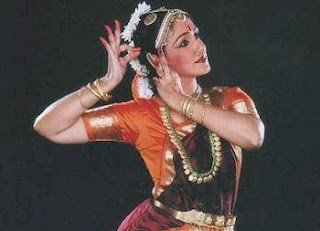SCENOGRAPHY IN INDIAN THEATRE
Dr. Satyabrata Rout
 |
| A performer creating the scene through Abhinaya |
We
all know that modern theatre is segregated into many disciplines; acting,
stage-design, costuming, light-design, makeup, choreography, etc. This is a
western concept which we have adopted from the British. This division requires
specialization in each field to achieve perfection in that discipline. But
Natyashatra never discussed on these compartmental divisions. It indicates towards a wholistic theatre
which can be achieved in its entirety. Scenography is also a segment of this
wholistic performance theory. The speciality of Classical Indian drama lies in
its performance which is presentational in its style of presentation rather
than representational, a common practice in Occidental culture. An Indian
performance never adopts life in its true form. It never perceives life from
its external viewpoint. In theatre the life is presented through metaphor and
symbols. Stylisation in the presentation is a common practice in Indian
theatre. The principle of presenting a [ii]patra-
character- on stage is also applied to the spatial presentations and scene
makings. The Aristotelian concept of space- unit of space- can’t be
implemented in Indian theatre. The space and the locals are constantly
established by the actors’ performance ability along with the power of the text
and their physical expressions. An existing local can be transformed into
another by a ritualistic performance of the actor- [iii]parikrama-in
front of the audience as per the demand of the text. The performance never
carries out anything with it; be it a space, character or a plot. For that
reason there are many locals, events and characters exist in one given time and
space in a single performance. Everything is expressed through the actors’ way
of presentation in an allegorical and symbolic approach.
Paul
Kuritz in his legendary book on “The making of theatre history” analysed;
[iv]“The
Indian stage used little scenery. The makeshift nature of the performance
required few scenic items; it exploited instead the Indian love for symbolism,
imagery, and costume. Sanskrit texts didn’t even indicate scenery, though
female stagehands may have changed the yavanika to suggest various rasas—white
for erotic settings, yellow for heroic, a dull colour for pathos, multicoloured
for farce, black for tragedy and red for violence. The Indian ranga was, like the
world, a neutral place where many different locations existed simultaneously.
Indian theatre thus aimed for less illusory imitation than the Greek theatre.”
 |
| Abhinaya through hasta mudra |
 |
| Performance of Kathakali |
We can’t completely deny with the fact that
Indian drama completely rejects the scenic elements. There are few properties
used by the actors in the name of scenography. In the ritualistic practice of [ix]Purvaranga-
prologue befor the play, the performers enter the stage with Jarjara dwaja
and fix it on the up stage near vedika. This colourful flag, visually
enriched was placed on the stage to mark the performance as a celebration,
since the colours in the flag represents the colours of life. Rangapatti
is another symbolic prop which was used for the entry and exit of the
characters in different scenes. The entry of actors behind this colourful
curtain provides visual elevation to the actors which add to the grandeur of
the performance. There are evidences of using some hand props by the
subordinate characters like; paricharika- female attendants and
servantsor chatra dharini (who holds the royal umbrella).
The scenography in Indian drama is more related
to the spiritual experiences than the bodily visual experiences. It flourishes
by the power of choreography and Natya. With the help of all the elements the
performance is able to transmit Rasa (sentiment) to the audience.
(Excerpts from my underwritten book "POETICS OF SPACE IN PERFORMANCE"
Notes....
[ii] The literary meaning of Patra is container. An actor
in Indian theatre is always compared with a Patra, means a medium which can
carry any ranga (colours or emotions) and can be able to reflect the colours in its purity. Broadly we can compare Patra with
characters.
[iii] Parikrama is a ritualistic practice of the Hindus. The
Hindus encircles the temple yard three times while visited the deities.
Probably the concept entered into the theatre practice where an actor changes
his locale by encircling the stage as a ritual.
[vi] A mythical king and the father of Bharata on whom the
name of the country Bharatavarsa (India) is adorned.
[vii] The play is written by Mahakavi Bhasa in 2nd
century BC. Thirteen number of plays written by Bhasa has been discovered yet.
[ix] It was a ritual, performed before the Ranga (play). It
consists of certain activities which includes Jarjara sthapane, Nandi patha,
Vishkambhaka etc.





